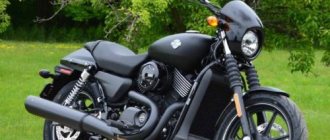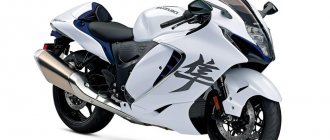- Kawasaki motorcycle model
Despite the long history of production of the Kawasaki KX125 and a huge number of generations, we should consider models starting from 1990 - that’s when the motorcycle received an inverted fork and features of modern motocross models. In addition, earlier versions are practically not represented on the market.
Features of the Kawasaki KX125 include a 2-stroke liquid-cooled engine with a power valve system (KIPS), a steel half-duplex frame, adjustable sports suspension, disc brakes, 21′ and 19′ wheels, an 8.5-liter fuel tank, 6-speed Gearbox and 87 kg dry weight.
2008 was the last year of production of the model, after which it finally left the market and received no further development. Instead, a 4-stroke modification of the Kawasaki KX250F was presented.
Brief history of the model
1974 - start of production and sales. First generation. Model: Kawasaki KX125 (North America). Factory designation: KX125-A1.
1975 - no significant changes. Model: Kawasaki KX125 (North America). Factory designation: KX125-A2.
1976 - no significant changes. Model: Kawasaki KX125 (North America). Factory designation: KX125-A3.
1978 - no significant changes. Model: Kawasaki KX125 (North America). Factory designation: KX125-A4.
1979 - no significant changes. Model: Kawasaki KX125 (North America). Factory designation: KX125-A5.
1980 - no significant changes. Model: Kawasaki KX125 (North America). Factory designation: KX125-A6.
1981 - no significant changes. Model: Kawasaki KX125 (North America). Factory designation: KX125-A7.
1982 - restyling of the model. Second generation. Model: Kawasaki KX125 (North America). Factory designation: KX125-B1.
1983 - no significant changes. Model: Kawasaki KX125 (North America). Factory designation: KX125-B2.
1984 - restyling of the model. Third generation. Model: Kawasaki KX125 (North America). Factory designation: KX125-C1.
1985 - restyling of the model. Fourth generation. Model: Kawasaki KX125 (North America). Factory designation: KX125-D1.
1986 - restyling of the model. Fifth generation. Model: Kawasaki KX125 (North America). Factory designation: KX125-E1.
1987 - no significant changes. Model: Kawasaki KX125 (North America). Factory designation: KX125-E2.
1988 - restyling of the model. Sixth generation. Model: Kawasaki KX125 (North America, Europe, Japan). Factory designation: KX125-F1.
1989 - restyling of the model. Seventh generation. Model: Kawasaki KX125 (North America, Europe, Japan). Factory designation: KX125-G1.
1990 - restyling of the model. Eighth generation. Model: Kawasaki KX125 (North America, Europe, Japan, Australia). Factory designation: KX125-H1.
1991 - no significant changes. Model: Kawasaki KX125 (North America, Europe, Japan, Australia). Factory designation: KX125-H2.
1992 - restyling of the model. Ninth generation. Model: Kawasaki KX125 (North America, Europe, Japan, Australia). Factory designation: KX125-J1.
1993 - no significant changes. Model: Kawasaki KX125 (North America, Europe, Japan, Australia). Factory designation: KX125-J2.
1994 - restyling of the model. Tenth generation. Model: Kawasaki KX125 (North America, Europe, Japan, Australia). Factory designation: KX125-K1.
1995 - no significant changes. Model: Kawasaki KX125 (North America, Europe, Japan, Australia). Factory designation: KX125-K2.
1996 - no significant changes. Model: Kawasaki KX125 (North America, Europe, Japan, Australia). Factory designation: KX125-K3.
1997 - no significant changes. Model: Kawasaki KX125 (North America, Europe, Japan, Australia). Factory designation: KX125-K4.
1998 - no significant changes. Model: Kawasaki KX125 (North America, Europe, Japan, Australia). Factory designation: KX125-K5.
1999 - restyling of the model. Eleventh generation. Model: Kawasaki KX125 (North America, Europe, Japan, Australia). Factory designation: KX125-L1.
2000 - no significant changes. Model: Kawasaki KX125 (North America, Europe, Japan, Australia). Factory designation: KX125-L2.
2001 - no significant changes. Model: Kawasaki KX125 (North America, Europe, Japan, Australia). Factory designation: KX125-L3.
2002 - no significant changes. Model: Kawasaki KX125 (North America, Europe, Japan, Australia). Factory designation: KX125-L4.
2003 - restyling of the model. Twelfth generation. Model: Kawasaki KX125 (North America, Europe, Japan, Australia). Factory designation: KX125-M1.
2004 - no significant changes. Model: Kawasaki KX125 (North America, Europe, Japan, Australia). Factory designation: KX125-M2.
2005 - no significant changes. Model: Kawasaki KX125 (North America, Europe, Japan, Australia). Factory designation: KX125-M3.
2006 - no significant changes. Model: Kawasaki KX125 (North America, Europe, Japan, Australia). Factory designation: KX125-M6F.
2007 - no significant changes. Model: Kawasaki KX125 (North America, Europe, Japan, Australia). Factory designation: KX125-M7F.
2008 is the last year of production. Model: Kawasaki KX125 (Europe, Japan, Australia). Factory designation: KX125-M8F.
Latest posts Popular The most interesting motorcycle news
you are reading the most popular news you are reading all the news you are reading the latest news read the most popular read all the news read the latest news
Over the past twenty years of production of this vehicle, it has undergone minor changes. It was able to acquire a slightly different stroke and piston diameter, a new generator and a different carburetor, while the frame and chassis of the Kawasaki KX 125 have not undergone any special changes since the late 70s. It should be noted that the point here is not about savings, but about the fact that this model was significantly ahead of its time, and as a result, the characteristics embedded in this bike were able to remain relevant even after several decades. Of course, this is not a professional motorcycle trial equipment. The KX 125 is a model for beginner motocross riders, and as such it is very good.
The absence of significant changes in the design over such a fairly long production time is easily explained. This vehicle can successfully cope with its tasks, whether a quarter of a century ago or now - so why change anything? The steel perimeter frame, Mikuni carburetor, excellent engine and 6-speed reverse gearbox are still as good today as they were when they were released. The upside-down fork copes well even with extreme loads, and the rear suspension is also quite good. By the way, the suspension travel is also impressive.
Everything else remains at the highest level. The dry weight of such a vehicle is less than 90 kilograms, which makes it possible for even bikers who are not particularly strong to handle the bike, and disc brakes on both wheels can very effectively stop such an iron horse if necessary. The gasoline tank has a capacity of 8.2 liters, which allows for long enough trips to tire you out. Anyone who has done motocross knows that after half an hour or an hour you can get as tired as bodybuilders sometimes don’t get tired when working out in gyms.
Of course, two-stroke engines, especially forced and small-capacity ones, cannot boast of an increased level of resources. This is a payment for the technical characteristics “removed” from them, sometimes head and shoulders above those of much larger motorcycles. However, anyone who wants to buy a good motocross motorcycle for themselves is most likely already aware of all the features of this class. We only want to note that, due to everything described above, the Kawasaki KX 125 is perfect for both beginner motocross riders and more experienced ones. Lightweight, simple in terms of design and aimed at beginners, it will, however, not let those who already know how to handle this kind of equipment get bored.
Technical characteristics of Kawasaki KX 125 2000s:
Technical characteristics of Kawasaki KX125 (KX125J-M, 1992-2008):
| Model | Kawasaki KX125 |
| Motorcycle type | cross |
| Year of issue | 1974-2008 |
| Frame | steel half-duplex |
| engine's type | 1-cylinder, 2-stroke |
| Working volume | 124 cm³ |
| Bore/Stroke | 54.0 x 54.5 mm |
| Compression ratio | 9.1:1 (low speed), 8.1:1 (high speed) – KX125J-K 9:8 (low rpm), 8.2:1 (high rpm) – KX125-L1 9.4:1 (low rpm), 7.9:1 (high rpm) – KX125-L2 10.6:1 (low speed),8.1:1 (high speed) – KX125-M1 11.1:1 (low speed),8.5:1 (high speed) – KX125-M2+ |
| Cooling | liquid |
| Number of valves per cylinder | |
| Fuel supply system | Carburetor, 1x Keihin PWK36 – KX125J-K Carburetor, 1x Keihin PWK36S – KX125-L Carburetor, 1x Mikuni TMX38X – KX125-M |
| Ignition type | CDI |
| Maximum power | 39.5 hp (29.0 kW) at 11250 rpm – KX125J-L |
| Maximum torque | 25.0 Nm (2.6 kg*m) at 11000 rpm – KX125J-L |
| Clutch | Multi-disc in oil bath, cable drive |
| Transmission | 6-speed |
| type of drive | chain |
| Front tire size | 80/100-21 51M |
| Rear tire size | 100/90-19 57M |
| Front brakes | 1 disc, 220 mm, 2-piston caliper – KX125J-M1 1 disc, 225 mm, 2-piston caliper – KX125-M2+ |
| Rear brakes | 1 disc, 190 mm, 1-piston caliper – KX125J-L 1 disc, 200 mm, 1-piston caliper – KX125-M1 1 disc, 215 mm, 1-piston caliper – KX125-M2+ |
| Front suspension | Inverted fork (adjustable), 310 mm travel – KX125J-L Inverted fork (adjustable), 300 mm travel – KX125-M |
| Rear suspension | Pendulum progressive Uni-Trak with monoshock (adjustable), travel - 330 mm - KX125J-L Pendulum progressive Uni-Trak with monoshock (adjustable), travel - 310 mm - KX125-M |
| Motorcycle length | 2160 mm – KX125-J 2150 mm – KX125-K 2130 mm – KX125-L 2155 mm – KX125-M1 2165 mm – KX125-M2+ |
| Motorcycle width | 815 mm – KX125J-L, KX125-M6F+ 825 mm – KX125-M1 840 mm – KX125M2-M3 |
| Motorcycle height | 1215 mm – KX125J-K 1210 mm – KX125-L 1200 mm – KX125-M1 1265 mm – KX125-M2+ |
| Wheelbase | 1470 mm – KX125-J, KX125-M2+ 1455 mm – KX125-K, KX125-M1 1435 mm – KX125-L1 1430 mm – KX125-L2 |
| Seat height | 950 mm – KX125J-K 945 mm – KX125-L 930 mm – KX125-M1 940 mm – KX125-M2+ |
| Minimum ground clearance (clearance) | 395 mm – KX125J-K 390 mm – KX125-L 340 mm – KX125-M |
| Acceleration 0-100 km/h | |
| Maximum speed | |
| Gas tank capacity | 8.5 l – KX125J-L 8.2 l – KX125-M |
| Motorcycle weight (dry) | 86.5 kg – KX125J-K 87 kg – KX125L-M |
| Motorcycle weight (curb) | 94 kg – KX125J-K 95 kg – KX125-L 92 kg – KX125-M |
TWO STROKES TUESDAY | 2001 KAWASAKI KX125 | FULL TEST
This is in the MXA test archive from the December 2000 issue of Motocross Action magazine. Get your MXA Subscription now
QUESTION ONE: Is a 2001 KX125 FAST?
How fast are you looking for? Quickly pull your hands out of their sockets? No. Do they quickly penetrate the berm? No. Quick-clean-three-easy-quick? No. Does he like to climb steep hills quickly? It's easy to drive fast. Yes.
QUESTION TWO: WHAT IS THE DEFINITION OF “EASY-FAST RIDING”?
In the official MXA Dictionary of Ambiguous Terms, it means a bike that uses other capabilities to make up for a lack of power.
QUESTION THREE: WHAT IS NOT THE KX125 ENGINE?
Nothing if you ask Kawasaki. It's the same old KX125 engine we learned to live with. We, like everyone else on the planet, thought (actually prayed) that Kawasaki would spend some serious money on research and development on the KX125 for 2001. They did! But they threw away most of the money. They ditched the heavy flywheel added last year, replaced the reed cage, replaced the Keihin with a Mikuni, and rearranged the ports. They just haven't expanded the powerband.
QUESTION FOUR: WHAT DID THEY GET FOR THEIR R&D MONEY?
They have an engine that produces competitive horsepower, but doesn't produce it in a way that translates into greatness. Don't get us wrong; The 2001 KX125 is Kawasaki's best 125 in three years. It's closer in power to its competitors than ever, it just lacks the breadth, usability and versatility that make the other 125 effective.
QUESTION FIVE: WHAT POWER DOES THE KX125 HAVE?
Middle and up. But, it's not the same as having a YZ125 or KTM 125SX. KH is closer to CR125; medium and high in the social stratum of loudmouths. The KX125 doesn't do anything wrong. All power comes on in the middle. Unfortunately, the Kawasaki's top hook doesn't go as far or as fast as the Yamaha and KTM's.
To ride the KX125 fast, you'll need a trigger finger on the clutch, a quick left foot, and asteroid-style timing. You may win on the KX125, but you'll be working harder than your competitors.
QUESTION SIX: WHAT ABOUT TRANSMISSION?
Feel free to change gears. The biggest improvement you can make to the 2001 KX125 is to replace the 49 tooth sprocket with a 50 tooth (maybe even a 51 for supercross style tracks).
QUESTION SEVEN: WHAT ABOUT THE STREAM?
We had some problems flying our KX125. It was rich at the bottom and in the middle, but leaned on top. We fixed this with a richer pilot.
Here's what we ran on our SoCal sea level track bike: Main Jet: 370 (360 stock) Pilot Plane: 45 (50 stock) Needle: 6BEF16-69 Slide: 5.5 Propeller: 1.5 turns (2 pcs) Clip : 3rd (4th stock)
QUESTION EIGHT: WHAT ABOUT THE REAR SUSPENSION?
Rejoice! Kawasaki has ditched its previous progressive rate shock spring in favor of a 4.9kg/mm straight rate shock spring (which is what we used last year). Stock shock is good. It has excellent valves and dual compression adjusters.
The only issue we had with the rear shock was its slight tendency to bounce when braking. What was our best setting? Spring rate: 4.9 kg/mm Race sag: 97mm Hi compression: 1 3/4 turns out Lo compression: 12 clicks Rebound: 13 clicks
QUESTION XNUMX: HOW GOOD FORKS ARE?
Hard. Kawasaki's SASS (Speed Activated Spring System), or bladder fork as it's known in the rest of the world, is in its second year and Kayaba has made a few changes to it. The biggest change is that they have reduced the amount of air in the system, raising the oil level by 20mm. Only this could be the reason for the rigidity. How do they work? Other than being exceptionally tough, everything is fine. You'll have to turn the compression dial all the way up before they actually start moving. You're probably thinking how could Kawasaki make them so stiff with 41kg/mm springs when Honda and Yamaha have 43kg/mm springs? It is a combination of valve and oil height. In our opinion, rigidity is a plus. We can't remember how many sets of forks we've tested that start out perfect and by the time we've ridden them for a month they've become soft. Our offer? Move using the clickers until the forks start to break. You can then use a compression clicker to strengthen them.
QUESTION TEN: WHAT ARE THE BEST FORK SETTINGS?
What was our best setting? For hardcore racing, we recommend the following setting: Spring Rate: 0.41kg/mm Oil Height: 90mm Compression: 20 clicks Rebound: 14 clicks Fork Leg Height: 5mm above top of leg Notes: Like Honda, Kawasaki offers a 20-in. front wheel. However, unlike the Honda where the 20″ tire looks amazing, the 20″ looks terrible on the Kawasaki. At first we thought it was because we weren't using the 20-inch Dunlop 739FA we'd come to love on Hondas except for us. The 20-inch model transforms the Kawasaki's stable front end into the ultimate monster.
QUESTION 11: HOW IS THIS HANDLED?
Like 200. No, not KDX200, but KX200. What is KX200? There's no such thing, but the KX125 still handles like one. It's similar to a small KX250, which means it's bigger than your standard tiddler. Why is this? The perimeter steel frame is large, wide and spring-loaded.
This is not necessarily a disadvantage. Every MXA test rider liked the larger size. It may seem like Kawasaki uses the same frame for its 125 and 250, but that's not the case. The KX125 frame is significantly smaller (15mm shorter at the head tube and 10mm shorter at the swingarm). These small differences make the KX125 a little more maneuverable than its big brother.
The extra room doesn't necessarily make for a great 125, but it doesn't seem to hurt. The KX125 shares most of its big brother's vertical handling traits - meaning it's adequate but not impressive (especially on berms and tight turns).
QUESTION 12: WHAT DO WE HATE?
Hate List: (1) Decals: We love the gold in the new decals, but just like the old ones, they start to peel from day one. (2) gas tank: Mr. KX, please empty the green plastic gas tank. It doesn't mean you save millions of dollars by making them all black. The black gas tank makes it difficult to see the fuel level. (3) Bar Clamps: We installed a KX250 top triple clamp on our KX125. The KX125 comes with solid booms, while the KX250 booms are rubber mounted and reversible. We felt the need to move the bars forward in the clamps. (4) Rudder: Rudders are prone to bending and don't necessarily fail before they start to peel paint where the crossbar joins. (5) Shift: This is a bit jagged. (6) Clutch: The clutch is borderline, although it may require more abuse than the KX250 kit. (7) Disks. U-shaped rims are nice, but we'd prefer standard rims. (8) Side Panels: There's a reason why Ricky Carmichael runs Berg Racing's side panel protection. He clings to the side panels with his boots, and so do we. Kawasaki needs to solve this problem so we don't have to spend $100 on a carbon fiber solution. (9) Front Brake Lever: Kawasaki used to have the second most advanced front brake lever in the business, but since Yamaha copied them this year, they both have a brake lever that has too many parts for the job at hand. Simplify it.
QUESTION 13: WHAT DO WE LIKE?
List of likes: (1) Pipe: The gray pipe coating is durable, rust-proof and beautiful. (2) Air filter: The air filter locating system uses two teeth. We like this, but always touch the airbox and make sure the bottom pin is in the hole. (3) Front Brake: We can't complain anymore about Kawasaki's poor front brake. They fixed the problem and we are helping them do it. (4) Guards: Only Kawasaki and KTM offer plastic guards to protect the frame from scratches. (5) Black boxes: This is a small thing, but Kawasaki has reduced the size of the huge black box that used to take up space in the air box. We prefer the small block. (6) Muffler: 6mm screws in the muffler end cap make removal easy. The muffler itself is 2 inches shorter than last year.
QUESTION 14: WHAT DO WE REALLY THINK?
Power is not as important as power range. The 2001 KX125 makes good power, and if you tap dance on the shifter and slip the clutch enough, you can get it moving quickly. But it's too much work. We'd love this bike if Kawasaki's engineers showed it some love - putting the tired old engine castings out to pasture and giving it a new heart.








